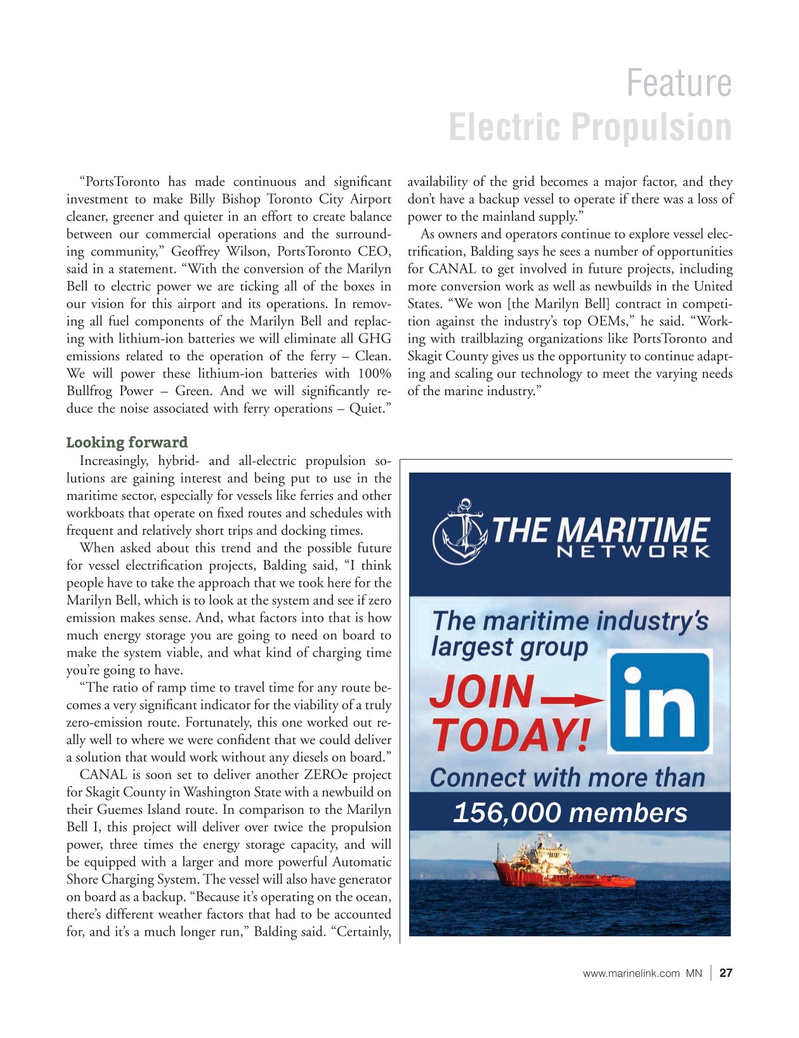
Page 27: of Marine News Magazine (January 2022)
Workboat Propulsion
Read this page in Pdf, Flash or Html5 edition of January 2022 Marine News Magazine
Feature
Electric Propulsion “PortsToronto has made continuous and signi? cant availability of the grid becomes a major factor, and they investment to make Billy Bishop Toronto City Airport don’t have a backup vessel to operate if there was a loss of cleaner, greener and quieter in an effort to create balance power to the mainland supply.” between our commercial operations and the surround- As owners and operators continue to explore vessel elec- ing community,” Geoffrey Wilson, PortsToronto CEO, tri? cation, Balding says he sees a number of opportunities said in a statement. “With the conversion of the Marilyn for CANAL to get involved in future projects, including
Bell to electric power we are ticking all of the boxes in more conversion work as well as newbuilds in the United our vision for this airport and its operations. In remov- States. “We won [the Marilyn Bell] contract in competi- ing all fuel components of the Marilyn Bell and replac- tion against the industry’s top OEMs,” he said. “Work- ing with lithium-ion batteries we will eliminate all GHG ing with trailblazing organizations like PortsToronto and emissions related to the operation of the ferry – Clean. Skagit County gives us the opportunity to continue adapt-
We will power these lithium-ion batteries with 100% ing and scaling our technology to meet the varying needs
Bullfrog Power – Green. And we will signi? cantly re- of the marine industry.” duce the noise associated with ferry operations – Quiet.”
Looking forward
Increasingly, hybrid- and all-electric propulsion so- lutions are gaining interest and being put to use in the maritime sector, especially for vessels like ferries and other workboats that operate on ? xed routes and schedules with frequent and relatively short trips and docking times.
When asked about this trend and the possible future for vessel electri? cation projects, Balding said, “I think people have to take the approach that we took here for the
Marilyn Bell, which is to look at the system and see if zero emission makes sense. And, what factors into that is how much energy storage you are going to need on board to make the system viable, and what kind of charging time you’re going to have.
“The ratio of ramp time to travel time for any route be- comes a very signi? cant indicator for the viability of a truly zero-emission route. Fortunately, this one worked out re- ally well to where we were con? dent that we could deliver a solution that would work without any diesels on board.”
CANAL is soon set to deliver another ZEROe project for Skagit County in Washington State with a newbuild on their Guemes Island route. In comparison to the Marilyn 156,000 members
Bell I, this project will deliver over twice the propulsion power, three times the energy storage capacity, and will be equipped with a larger and more powerful Automatic
Shore Charging System. The vessel will also have generator on board as a backup. “Because it’s operating on the ocean, there’s different weather factors that had to be accounted for, and it’s a much longer run,” Balding said. “Certainly, www.marinelink.com MN 27|

 26
26

 28
28
